语音学与音位学的区别
英语语音学和音位学

The Front Vowels
There are 4 front vowels in English: /i:/, /i/, /e/, /æ/ . /i:/ is a long, close front vowel. It is unrounded and tense.【sea leave】
Three main areas
ARTICULATORY PHONETICS(发音语言 学)is study of the production of speech sounds. ACOUSTIC PHONETICS(声学语言学)is the physical properties of the speech sounds. PERCEPTUAL or AUDITORY PHONETICS(感知,听觉语言学)is concerned with the perception of speech sounds.
颤音(TRILL)【r】
触音(TAP)【t d n】city
塞擦音(AFFRICATE)【ts dz tr dr】 church【tʃ】
发音部位指辅音的发音位置,辅音可以产 生于唇与声带间的任何部位。 在国际音标中区分了11个发音部位。 ①双唇音(BILABIAL)【p b m】pet ,bet ②唇齿音(LABIODENTAL)如fire中【f】 ③齿音(DENTAL)【θð】 ④齿龈音(ALVEOLAR)【t d n s r l】 ⑤齿龈后音(POSTALVEOLAR)【ʃ ʒ】
The closing Diphthongs合口双元 音
There are five closing diphthongs in English. /ei/, /ai/ , /ɔi/, /əu/ , /au/ Байду номын сангаасei/ begins with /e/ and glides smoothly to /i/【stay say】 /ai/ glides from /a/ to /i/ . It is smooth and loudness becomes less as it progresses.【by shy】 /ɔi/ glides from a position between /ɔ/ and /ɔ:/ to /i/.【boy toy】 /əu/ starts with /ə:/ and then glides away to /u/ with the lips getting slightly rounded.【boat coat】 /au/ starts with /a/ and then glides away to /u/ with the lips getting slightly rounded.【house mouse 】
《语言学教程》第 2 章 语音学与音位学1

语音学研究的是语音, 发出、
语音如何 即 以及对 传递 和感知
语音
词 连续性语音 的描写 和分类。
Phonetics studies how speech sounds are produced, transmitted, and perceived.
Articulatory phonetics / 发音语音学 is the study of the production of speech sounds.
①SPEECH ORGANS, also knows as VOCAL ORGANS, are those parts of the human body involved in the production of speech. ②It is striking to see how much of the human body is involved in the production of speech: the lungs, the trachea (or windpipe), the throat, the nose, and the mouth.
3 and ultimately we aim to discover the rules that underlie the sound patterns of all languages.
In this chapter, we will introduce and discuss some of the basic ideas of articulatory phonetics and phonological analysis.
的规则。
音位学以音位为起点来研究语言的语音系统。
英语语言学

英语语言学语言学普遍被定义为对语言进行科学研究,他试图回答如下基本问题:什么是语言,语言是如何运作的。
主要包括了普通语言学,语音学,音位学,形态学,句法学,语义学,语用学等部分。
本文重点介绍了语音学,音位学和形态学,并提出了学习中一些自己的想法。
一语音学口语交际的媒介是语音(speech sounds),也就是说人们通过声道(vocal track)发出的音来表达意义。
这种对语音的研究被叫做语音学(phonetics)。
语音学主要包括了如下内容。
发音器官语音是由各种发音器官(speech organ)而产生的。
因此,正确理解语音需要掌握相关的发音系统知识。
人的发音器官包含在咽腔,口腔,鼻腔三个区域中。
英语语音的表征方法通常我们使用国际音标来代表语音,也就是我们常说的宽式音标。
在描写语音时,为了体现语音的细微差异,语言学使用更为详细的标音方法,有时被称为严式记音(narrow transcription)。
在窄式记音中,一些较小符号经常被附加在音标上,如鼻化符[ ˘ ]、重音符[ˊ]等。
这些改变音值的较小记号叫做变音符(diacritic)。
英语语音的分类英语语音主要分为元音(vowels)和辅音(consonants) 两类。
他们的主要区别是:发元音时,发音器官不形成阻碍,气流可以畅通无阻地经口腔或鼻腔流出;发辅音时,发音器官某一部位形成阻碍,气流必须克服阻碍才能通过。
辅音可以根据发音部位(places of articulation)、发音方式(manners of articulation)进行分类和描写。
在发元音时,没有类似发辅音时产生的气流受阻的现象,因此,描写元音不能沿用描写辅音的方法。
语言学家通常依据以下三个原则对元音进行描写:(1)嘴的张合度; (2)舌头抬升的部位---- 前、中、后;(3)唇的开合度——唇的圆或展的不同程度;二音位学音位学(phonology)和语音学一样都是对语音的研究,但两者研究的视角却不同。
音素、音位、音位变体的区别
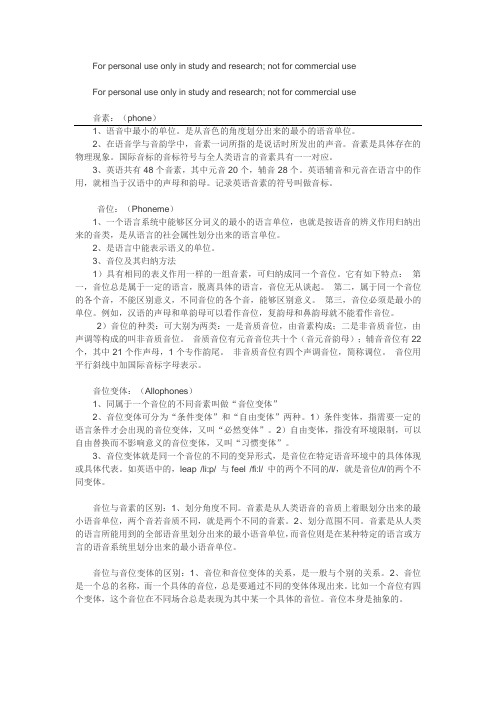
For personal use only in study and research; not for commercial useFor personal use only in study and research; not for commercial use音素:(phone)1、语音中最小的单位。
是从音色的角度划分出来的最小的语音单位。
2、在语音学与音韵学中,音素一词所指的是说话时所发出的声音。
音素是具体存在的物理现象。
国际音标的音标符号与全人类语言的音素具有一一对应。
3、英语共有48个音素,其中元音20个,辅音28个。
英语辅音和元音在语言中的作用,就相当于汉语中的声母和韵母。
记录英语音素的符号叫做音标。
音位:(Phoneme)1、一个语言系统中能够区分词义的最小的语言单位,也就是按语音的辨义作用归纳出来的音类,是从语言的社会属性划分出来的语言单位。
2、是语言中能表示语义的单位。
3、音位及其归纳方法1)具有相同的表义作用一样的一组音素,可归纳成同一个音位。
它有如下特点:第一,音位总是属于一定的语言,脱离具体的语言,音位无从谈起。
第二,属于同一个音位的各个音,不能区别意义,不同音位的各个音,能够区别意义。
第三,音位必须是最小的单位。
例如,汉语的声母和单韵母可以看作音位,复韵母和鼻韵母就不能看作音位。
2)音位的种类:可大别为两类:一是音质音位,由音素构成;二是非音质音位,由声调等构成的叫非音质音位。
音质音位有元音音位共十个(音元音韵母);辅音音位有22个,其中21个作声母,1个专作韵尾。
非音质音位有四个声调音位,简称调位。
音位用平行斜线中加国际音标字母表示。
音位变体:(Allophones)1、同属于一个音位的不同音素叫做“音位变体”2、音位变体可分为“条件变体”和“自由变体”两种。
1)条件变体,指需要一定的语言条件才会出现的音位变体,又叫“必然变体”。
2)自由变体,指没有环境限制,可以自由替换而不影响意义的音位变体,又叫“习惯变体”。
语言学知识总结

TEM-8 语言学知识复习总结重要概念梳理CNU 张旭ZX第一节语言的本质一、语言的普遍特征(Design Features)1.任意性Arbitratriness:shu 和Tree都能表示“树”这一概念;同样的声音,各国不同的表达方式2.双层结构Duality:语言由声音结构和意义结构组成(the structure of sounds andmeaning)3.多产性productive:语言可以理解并创造无限数量的新句子,是由双层结构造成的结果(Understand and create unlimited number with sentences)4.移位性Displacemennt:可以表达许多不在场的东西,如过去的经历、将来可能发生的事情,或者表达根本不存在的东西等5.文化传播性Cultural Transmission:语言需要后天在特定文化环境中掌握二、语言的功能(Functions of Language)1. 1. 传达信息功能Informative:最主要功能The main function2. 2. 人际功能Interpersonal:人类在社会中建立并维持各自地位的功能establish and maintain their identity3. 3. 行事功能performative:现实应用——判刑、咒语、为船命名等Judge,naming,and curses4. 4. 表情功能Emotive:表达强烈情感的语言,如感叹词/句exclamatoryexpressions5. 5. 寒暄功能Phatic:应酬话phatic language,比如“吃了没?”“天儿真好啊!”等等6. 6. 元语言功能Metalingual:用语言来谈论、改变语言本身,如book可以指现实中的书也可以用“book这个词来表达作为语言单位的“书”三、语言学的分支1. 核心语言学Core linguisticl 语音学Phonetics:关注语音的产生、传播和接受过程,着重考察人类语言中的单音。
英语语言学术语
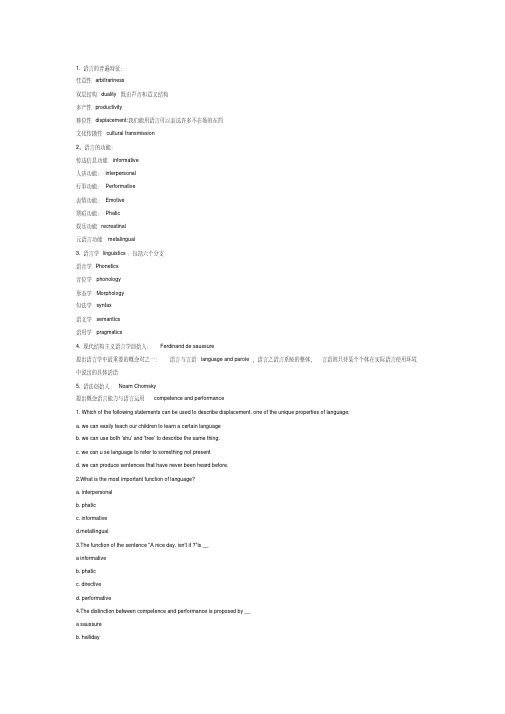
1. 语言的普遍特征:任意性arbitrariness双层结构duality 既由声音和意义结构多产性productivity移位性displacement:我们能用语言可以表达许多不在场的东西文化传播性cultural transmission2。
语言的功能:传达信息功能informative人济功能:interpersonal行事功能:Performative表情功能:Emotive寒暄功能:Phatic娱乐功能recreatinal元语言功能metalingual3. 语言学linguistics:包括六个分支语音学Phonetics音位学phonology形态学Morphology句法学syntax语义学semantics语用学pragmatics4. 现代结构主义语言学创始人:Ferdinand de saussure提出语言学中最重要的概念对之一:语言与言语language and parole ,语言之语言系统的整体,言语则只待某个个体在实际语言使用环境中说出的具体话语5. 语法创始人:Noam Chomsky提出概念语言能力与语言运用competence and performance1. Which of the following statements can be used to describe displacement. one of the unique properties of language:a. we can easily teach our children to learn a certain languageb. we can use both 'shu' and 'tree' to describe the same thing.c. we can u se language to refer to something not presentd. we can produce sentences that have never been heard before.2.What is the most important function of language?a. interpersonalb. phaticc. informatived.metallingual3.The function of the sentence "A nice day, isn't it ?"is __a informativeb. phaticc. directived. performative4.The distinction between competence and performance is proposed by __a saussureb. hallidayd. the prague school5. Who put forward the distinction between language and parole?a. saussureb. chomskyc. hallidayd anomymous第二节语音学1.发音器官由声带the vocal cords和三个回声腔组成2.辅音consonant:there is an obstruction of the air stream at some point of the vocal tract.3.辅音的发音方式爆破音complete obstruction鼻音nasals破裂音plosives部分阻塞辅音partial obstruction擦音fricatives破擦音affricates等4.辅音清浊特征voicing辅音的送气特征aspiration5.元音vowel分类标准舌翘位置,舌高和嘴唇的形状6双元音diphthongs,有元音过渡vowel glides1. Articulatory phonetics mainly studies __.a. the physical properties of the sounds produced in speechb. the perception of soundsc. the combination of soundsd. the production of sounds2. The distinction between vowel s and consonants lies in __a. the place of articulationb.the obstruction f airstreamc. the position of the tongued. the shape of the lips3. What is the common factor of the three sounds: p, k ta. voicelessb. spreadc.voicedd.nasal4. What phonetic feature distinguish the p in please and the p in speak?a. voicingb. aspirationc.roundnessd. nasality5.Which of the following is not a distinctive feature in English?a. voicingc. approximationd. aspiration6.The phonological features of the consonant k are __a. voiced stopb. voiceless stopc. voiced fricatived. voiceless fricative7.p is divverent from k in __a. the manner of articulationb. the shape of the lipsc. the vibration of the vocal cordsd.the palce of articualtion8.Vibration of the vocal cords results in __a. aspirationb.nasalityc. obstructiond. voicing第三节音位学phonology1.音位学与语音学的区别:语音学着重于语音的自然属性,主要关注所有语言中人可能发出的所有声音;音位学则强调语音的社会功能,其对象是某一种语言中可以用来组合成词句的那些语音。
英语专八人文知识之语言学部分

复习专八的同志们注意啦,个人潜心整理--人文知识之语言学部分,希望能帮上点儿忙,一起加油!作者:張旭BEYONDTEM-8 语言学知识复习总结重要概念梳理CNU 张旭ZX第一节语言的本质一、语言的普遍特征(Design Features)1任意性Arbitratriness:shu 和Tree都能表示“树”这一概念;同样的声音,各国不同的表达方式2双层结构Duality:语言由声音结构和意义结构组成(the structure of sounds and meaning)3多产性productive:语言可以理解并创造无限数量的新句子,是由双层结构造成的结果(Understand and create unlimited number with sentences)4移位性Displacemennt:可以表达许多不在场的东西,如过去的经历、将来可能发生的事情,或者表达根本不存在的东西等5文化传播性Cultural Transmission:语言需要后天在特定文化环境中掌握二、语言的功能(Functions of Language)6 1. 传达信息功能Informative:最主要功能The main function7 2. 人际功能Interpersonal:人类在社会中建立并维持各自地位的功能establish and maintain their identity8 3. 行事功能performative:现实应用——判刑、咒语、为船命名等Judge,naming,and curses9 4. 表情功能Emotive:表达强烈情感的语言,如感叹词/句exclamatoryexpressions10 5. 寒暄功能Phatic:应酬话phatic language,比如“吃了没?”“天儿真好啊!”等等11 6. 元语言功能Metalingual:用语言来谈论、改变语言本身,如book可以指现实中的书也可以用“book这个词来表达作为语言单位的“书”三、语言学的分支1. 核心语言学Core linguisticl 语音学Phonetics:关注语音的产生、传播和接受过程,着重考察人类语言中的单音。
胡壮麟的语言学术语英汉对照翻译表

胡壮麟的语言学术语英汉对照翻译表1. 语言的普遍特征:任意性arbitrariness双层结构duality 既由声音和意义结构多产性productivity移位性displacement:我们能用语言可以表达许多不在场的东西文化传播性cultural transmission2。
语言的功能:传达信息功能informative人济功能:interpersonal行事功能:Performative表情功能:Emotive寒暄功能:Phatic娱乐功能recreatinal元语言功能metalingual3. 语言学linguistics:包括六个分支语音学Phonetics音位学phonology形态学Morphology句法学syntax语义学semantics语用学pragmatics4. 现代结构主义语言学创始人:Ferdinand de saussure提出语言学中最重要的概念对之一:语言与言语language and parole ,语言之语言系统的整体,言语则只待某个个体在实际语言使用环境中说出的具体话语5. 语法创始人:Noam Chomsky提出概念语言能力与语言运用competence and performance1. Which of the following statements can be used to describe displacement. one of the unique properties of language:a. we can eas ily teach our children to learn a certain languageb. we can use both 'shu' and 'tree' to describe the same thing.c. we can u se language to refer to something not presentd. we can produce sentences that have never been heard before.2.What is the most important function of language?a. interpersonalb. phaticc. informatived.metallingual3.The function of the sentence "A nice day, isn't it ?"is __a informativeb. phaticc. directived. performative4.The distinction between competence and performance is proposed by __a saussureb. hallidayc. chomskyd. the prague school5. Who put forward the distinction between language and parole?a. saussureb. chomskyc. hallidayd anomymous第二节语音学1.发音器官由声带the vocal cords和三个回声腔组成2.辅音consonant:there is an obstruction of the air stream at some point of the vocal tract.3.辅音的发音方式爆破音complete obstruction鼻音nasals破裂音plosives部分阻塞辅音partial obstruction擦音fricatives破擦音affricates等4.辅音清浊特征voicing辅音的送气特征aspiration5.元音vowel分类标准舌翘位置,舌高和嘴唇的形状6双元音diphthongs,有元音过渡vowel glides1. Articulatory phonetics mainly studies __.a. the physical properties of the sounds produced in speechb. the perception of soundsc. the combination of soundsd. the production of sounds2. The distinction between vowel s and consonants lies in __a. the place of articulationb.the obstruction f airstreamc. the position of the tongued. the shape of the lips3. What is the common factor of the three sounds: p, k ta. voicelessb. spreadc.voicedd.nasal4. What phonetic feature distinguish the p in please and the p in speak?a. voicingb. aspirationc.roundnessd. nasality5.Which of the following is not a distinctive feature in English?a. voicingb.nasalc. approximationd. aspiration6.The phonological features of the consonant k are __a. voiced stopb. voiceless stopc. voiced fricatived. voiceless fricative7.p is divverent from k in __a. the manner of articulationb. the shape of the lipsc. the vibration of the vocal cordsd.the palce of articualtion8.Vibration of the vocal cords results in __a. aspirationb.nasalityc. obstructiond. voicing第三节音位学phonology1.音位学与语音学的区别:语音学着重于语音的自然属性,主要关注所有语言中人可能发出的所有声音;音位学则强调语音的社会功能,其对象是某一种语言中可以用来组合成词句的那些语音。
语言学知识复习总结
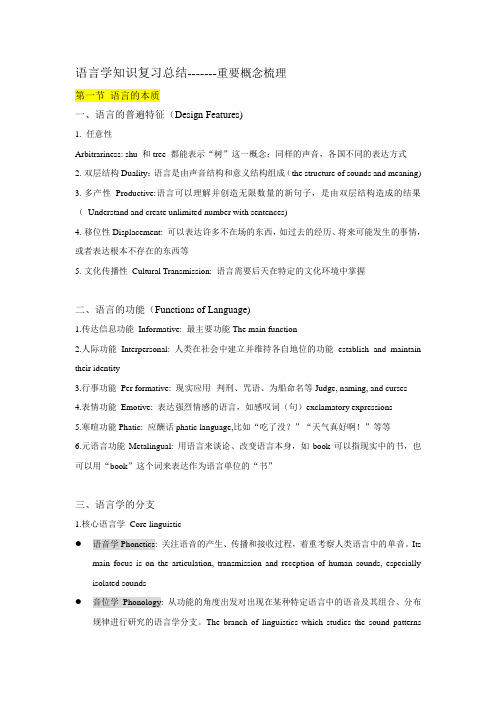
语言学知识复习总结-------重要概念梳理第一节语言的本质一、语言的普遍特征(Design Features)1. 任意性Arbitrariness: shu 和tree 都能表示“树”这一概念;同样的声音,各国不同的表达方式2.双层结构Duality:语言是由声音结构和意义结构组成(the structure of sounds and meaning)3.多产性Productive:语言可以理解并创造无限数量的新句子,是由双层结构造成的结果(Understand and create unlimited number with sentences)4.移位性Displacement: 可以表达许多不在场的东西,如过去的经历、将来可能发生的事情,或者表达根本不存在的东西等5.文化传播性Cultural Transmission: 语言需要后天在特定的文化环境中掌握二、语言的功能(Functions of Language)1.传达信息功能Informative: 最主要功能The main function2.人际功能Interpersonal: 人类在社会中建立并维持各自地位的功能establish and maintain their identity3.行事功能Per formative: 现实应用--判刑、咒语、为船命名等Judge, naming, and curses4.表情功能Emotive: 表达强烈情感的语言,如感叹词(句)exclamatory expressions5.寒暄功能Phatic: 应酬话phatic language,比如“吃了没?”“天气真好啊!”等等6.元语言功能Metalingual: 用语言来谈论、改变语言本身,如book可以指现实中的书,也可以用“book”这个词来表达作为语言单位的“书”三、语言学的分支1.核心语言学Core linguistic●语音学Phonetics: 关注语音的产生、传播和接收过程,着重考察人类语言中的单音。
汉德语音和音位的对比PPT精选文档

汉德语音音位比较 Kontrastive Analyse von beiden Sprache:die Phoneme und das Vokal
2
一些语音概念的定义
• 音节(Silbe):是人能够自然发出的、最小的语音单位。 • 音素(Laute):人能够发出的、最小的语音单位。
相关参考资料
• 《汉德语言实用对比研究》 -钱文彩著 2006 外研社 • 《语言学纲要》叶蜚声、徐通锵 1997 北大出版社 • 《现代汉语》黄伯荣、廖旭东 1990 高等教育出版社
19
17
Fazit
• 1、发音器官紧张程度不同,德语更紧张; • 2、非音质音位方面,德语中长短可以区别意义,汉语则以四个声调区
别意义; • 3、德语元音较稳定,复合元音少,汉语元音多,元音变体多; • 4、德语对偶辅音音位以清浊音相对立,汉语的对偶辅音以送气与不送
气相对立; • 5、翘舌音音位。
18
前面提到过: 音位是一种语言系统中具有区别意义作用的最小的语音单位。 音位的辨别:在一种语言系统中,相同语音环境中能够区别意义的语音
单位就是一个音位。 如汉语中lǔ和ǚ,声母和声调完全相同,而韵母u和ü的差别使两个字的意
义区别开来。这样u和ü在汉语中就是两个音位。 如德语的Doch和Dach,同理a和o是两个音位。
国际音标记录的是音素。用[]里面加字母来表示。
• 音位(Phoneme):是某一种语音系统中,能够区别意义的
最小语音单位。 拼音文字记录的是某种语言的音位,而不是音素。
3
元音和辅音Was ist der Unterschied zwischen das Konsonant(辅
英语专八人文知识 语言学必背第3讲-音位学

英语专八人文知识语言学必背第3讲:音位学第三节音位学Phonology一、基本概念及区分1.广义音位学指对自然语言声音系统的一般性特征研究,可以包括语音学;狭义的音位学主要研究言语语音组合方式模式及变化,普通语言学取其狭义2.音位学与语音学的区别:Phonetics 着重语言的自然属性physical properties,关注所有语言中人可能发出的所有声音,是音位学研究的基础;Phonology着重强调语音的社会功能social functions,对象是某种语言中可以用来组合成词句的那些语音二、重要概念1.音位Phoneme:在语言中具有区别表义单位作用的最小语音单位the smallest unit that is capable of distinguishing or contrasting wordsE.g: pig 和big中的/p/和/b/就是独立的音位。
2.音位变体Allophones:没有区分表义单位作用的音段E.g:同样/s/音,在shoe和she中读音却有差别,若把两个有差别的/s/音调换位置,并不会改变单词意义,只是有点别扭。
所以,这两音就叫做/s/的音位变体。
注Phoneme和Allophone的区别:音位具有区别性,是抽象、理想化的单位,具有系统性;音位变体都属于同一个音位,他们共同代表或者源于音位,是音位在实际环境中的体现。
3.最小语音对Minimal Pairs:两个词互相之间的差别只是一个音段,就是最小语音对;可以确定某个音段是否为音位E.g:pen 和pin就是M-p,可以确定/e/和/i/4.两种分布关系对比性分布Contrastive Distribution若两个音段出现在同一个语音环境中而产生了两个不同的单词,则处于对比性分布关系。
最小语音对中的不同音段就是这种关系。
3.中的例子互补性分布Complementary distribution若两个基本相似的音段绝不会出现在相同的语音环境中,则它们之间就是互补性分布的关系。
英语语言学练习题1
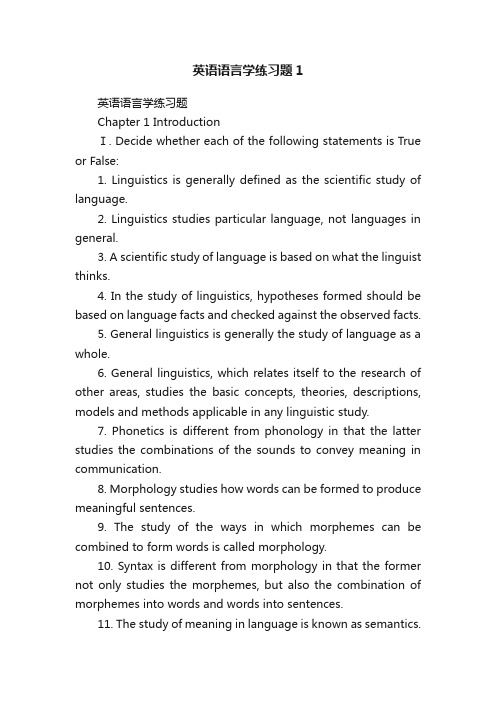
英语语言学练习题1英语语言学练习题Chapter 1 IntroductionⅠ. Decide whether each of the following statements is True or False:1. Linguistics is generally defined as the scientific study of language.2. Linguistics studies particular language, not languages in general.3. A scientific study of language is based on what the linguist thinks.4. In the study of linguistics, hypotheses formed should be based on language facts and checked against the observed facts.5. General linguistics is generally the study of language as a whole.6. General linguistics, which relates itself to the research of other areas, studies the basic concepts, theories, descriptions, models and methods applicable in any linguistic study.7. Phonetics is different from phonology in that the latter studies the combinations of the sounds to convey meaning in communication.8. Morphology studies how words can be formed to produce meaningful sentences.9. The study of the ways in which morphemes can be combined to form words is called morphology.10. Syntax is different from morphology in that the former not only studies the morphemes, but also the combination of morphemes into words and words into sentences.11. The study of meaning in language is known as semantics.12. Both semantics and pragmatics study meanings.13. Pragmatics is different from semantics in that pragmatics studies meaning not in isolation, but in context.14. Social changes can often bring about language changes.15. Sociolinguistics is the study of language in relation to society.16. Modern linguistics is mostly prescriptive, but sometimes descriptive.17. Modern linguistics is different from traditional grammar.18. A diachronic study of language is the description of language at some point in time.19. Modern linguistics regards the written language as primary, not the written language.20. The distinction between competence and performance was proposed by F. de Saussure.Ⅱ. Fill in each of the following blanks wit h one word which begins with the letter given:21. Chomsky(乔姆斯基)defines “competence” as the ideal user’s k__________ of the rules of his language.22. Langue refers to the a__________ linguistic system shared by all the members of a speech community while the parole is the concrete use of the conventions and application of the rules.23. D_________ is one of the design features of human language which refers to the phenomenon that language consists of two levels: a lower level of meaningless individual sounds and a higher level of meaningful units.24. Language is a system of a_________ vocal symbols used for human communication.25. The discipline that studies the rules governing the formation of words into permissible sentences in languages iscalled s________.26. Human capacity for language has a g_______ basis, but the details of language have to be taught and learned.27. P _______ refers to the realization of langue in actual use.28. Findings in linguistic studies can often be applied to the settlement of some practical problems. The study of such applications is generally known as a________ linguistics.29. Language is p___________ in that it makes possible the construction and interpretation of new signals by its users. In other words, they can produce and understand an infinitely large number of sentences which they have never heard before.30. Linguistics is generally defined as the s _______ study of language.Ⅲ. There are four choices following each statement. Mark the choice that can best complete the statement:31. If a linguistic study describes and analyzes the language people actually use, it is said to be _______.A. prescriptiveB. analyticC. descriptiveD. linguistic32. Which of the following is not a design feature of human language?A. ArbitrarinessB. DisplacementC. DualityD. Meaningfulness33. Modern linguistics regards the written language as _______.A. primaryB. correctC. secondaryD. stable34. In modern linguistics, speech is regarded as more basic than writing, because _______.A. in linguistic evolution, speech is prior to writingB. speech plays a greater role than writing in terms of the amount of information conveyedC. speech is always the way in which every native speaker acquires his mother tongueD. All of the above35. A historical study of language is a _______ study of language.A. synchronicB. diachronicC. prescriptiveD. comparative36. Saussure took a(n) _______ view of language, while Chomsky looks at language from a ________ point of view.A. sociologica l…psychologicalB. psychological…sociologicalC. applied…pragmaticD.semantic…linguistic37. According to F. de Saussure, _______ refers to the abstract linguistic system shared by all the mem- bers of a speech community.A. paroleB. performanceC. langueD. Language38. Language is said to be arbitrary because there is no logical connection between _______ and meanings.A. senseB. soundsC. objectsD. ideas39. Language can be used to refer to contexts removed from the immediate situations of the speaker. This feature is called _______,A. displacementB. dualityC. flexibilityD. cultural transmission40. The details of any language system is passed on from one generation to the next through _______, rather than by instinct.A. learningB. teachingC. booksD. both A and BⅣ. Define the following terms:41. Linguistics42. Phonology43. Syntax44. Pragmatics 45. Psycholinguistics46. Language47. Phonetics48. Morphology49. Semantics50. Sociolinguistics51. Applied Linguistics52. Arbitrariness53. Productivity54. Displacement55. Duality56. Design Features 57. Competence58. Performance59. Langue60. ParoleⅤ. Answer the following questions as comprehensively aspossible. Give examples for illustration if necessary:61. Language is generally defined as a system of arbitrary vocal symbols used for human commu- nication. Explain it in detail.62. What are the design features of human language? Illustrate them with examples.63. How is modern linguistics different from traditional grammar?64. How do you understand the distinction between a synchronic study and a diachronic study?65. Why does modern linguistics regard the spoken form of language as primary, not the written?66. What are the major distinctions between langue and parole?67. How do you understand competence and performance?68. Saussure’s distinction between langue and parole seems similar to Chomsky’s distinction between competence and performanc e. What do you think are their major differences?69. Do you think human language is entirely arbitrary? Why?Chapter 2 Phonology语音体系Ⅰ. Decide whether each of the following statements is True or False:1. V oicing is a phonological feature that distinguishes meaning in both Chinese and English.2. If two phonetically similar sounds occur in the same environments and they distinguish meaning, they are said to be in complementary distribution.3. A phone is a phonetic unit that distinguishes meaning.4. English is a tone language while Chinese is not.1. 语言的普遍特征:任意性arbitrariness双层结构duality 既由声音和意义结构多产性productivity移位性displacement:我们能用语言可以表达许多不在场的东西文化传播性cultural transmission2. 语言的功能:传达信息功能informative人济功能:interpersonal行事功能:Performative表情功能:Emotive寒暄功能:Phatic娱乐功能recreatinal元语言功能metalingual3. 语言学linguistics:包括六个分支语音学Phonetics音位学phonology形态学Morphology句法学syntax语义学semantics语用学pragmatics4. 现代结构主义语言学创始人:Ferdinand de saussure提出语言学中最重要的概念对之一:语言与言语language and parole ,语言之语言系统的整体,言语则只待某个个体在实际语言使用环境中说出的具体话语5. 语法创始人:Noam Chomsky提出概念语言能力与语言运用competence and performance1. Which of the following statements can be used to describe displacement. one of the unique properties of language:a. we can easily teach our children to learn a certain languageb. we can use both 'shu' and 'tree' to describe the same thing.c. we can u se language to refer to something not presentd. we can produce sentences that have never been heard before.2.What is the most important function of language?a. interpersonalb. phaticc. informatived.metallingual3.The function of the sentence "A nice day, isn't it ?"is __a informative b. phatic c. directive d. performative4.The distinction between competence and performance is proposed by __a saussure b. halliday c. Chomsky d. the prague school5. Who put forward the distinction between language and parole?a. saussureb. chomskyc. halliday d anomymous第二节语音学1.发音器官由声带the vocal cords和三个回声腔组成2.辅音consonant:there is an obstruction of the air stream at some point of the vocal tract.3.辅音的发音方式爆破音complete obstruction鼻音nasals破裂音plosives部分阻塞辅音partial obstruction擦音fricatives破擦音affricates等4.辅音清浊特征voicing辅音的送气特征aspiration5.元音vowel分类标准舌翘位置,舌高和嘴唇的形状6双元音diphthongs,有元音过渡vowel glides1. Articulatory phonetics mainly studies __.a. the physical properties of the sounds produced in speechb. the perception of soundsc. the combination of soundsd. the production of sounds2. The distinction between vowel s and consonants lies in __a. the place of articulationb.the obstruction f airstreamc. the position of the tongued. the shape of the lips3. What is the common factor of the three sounds: p, k ta. voicelessb. spreadc.voicedd.nasal4. What phonetic feature distinguish the p in please and the p in speak?a. voicingb. aspirationc.roundnessd. nasality5.Which of the following is not a distinctive feature in English?a. voicingb.nasalc. approximationd. aspiration6.The phonological features of the consonant k are __a. voiced stopb. voiceless stopc. voiced fricatived. voiceless fricative7.p is divverent from k in __a. the manner of articulationb. the shape of the lipsc. the vibration of the vocal cordsd.the palce of articualtion8.Vibration of the vocal cords results in __a. aspirationb.nasalityc. obstructiond. voicing第三节音位学phonology1.音位学与语音学的区别:语音学着重于语音的自然属性,主要关注所有语言中人可能发出的所有声音;音位学则强调语音的社会功能,其对象是某一种语言中可以用来组合成词句的那些语音。
英语语言学框架

英语语言学框架作为全球最流行的语言,英语对于我们的日常交流和学习有着重要的作用。
然而,要想深入理解和掌握英语语言,我们需要了解英语语言学框架。
下面将分步骤阐述英语语言学框架的重要内容。
第一步:音位学英语语言的音位学研究了英语中的音素、音与音之间的关系以及发音的规则。
英语中的音素有44个,包括元音、辅音、浊音和清音等。
此外,英语中也有许多发音规则,如元音的发音通常取决于它们在单词中的位置,辅音与元音的搭配也有一定规则等。
第二步:语音学英语语音学研究了音素、音型、音调和语调等问题。
其中,音型指的是单词和句子中的语音形态,音调是说话时发音抑扬顿挫的高低音节奏,而语调则是比音调更高层次的整个句子的语言基调和表情。
第三步:词法学英语词法学研究了英语单词的构成、分类、词性及其语法功能。
英语中的单词可以分为名词、动词、形容词、副词等。
在语法上,单词的不同词性会对句子的结构和语法功能产生不同的影响。
第四步:句法学英语句法学研究了英语句子的构成和结构。
英语中的句子有四种基本结构,即主语+谓语、主语+谓语+宾语、主语+谓语+表语、主语+谓语+宾语+宾语补足语。
在句子的构成过程中,还需要考虑主谓一致、时态以及语态等问题。
第五步:语义学英语语义学研究了英语单词和句子的意义。
在英语中,单词的意义受到一定的语境、词义辨析等因素的影响。
此外,英语中的句子也需要考虑上下文的语境和语用功能,以更好地理解句子的意思。
总之,英语语言学框架是我们深入理解英语语言的重要工具。
通过学习英语的音位学、语音学、词法学、句法学和语义学等内容,可以更加全面地掌握英语的使用方法和语言规则,提升英语的听、说、读、写等各方面的能力。
【实用】语音学和音位学PPT资料

区别特征(Distinctive Features)
音位可以分解为不同的语音特征, 如[b]就可以分解为“浊音、双唇音 和塞音”;有一部分语音特征可以 区分不同的音位,这一部分语音特 征就称为区别特征。
Suprasegmental Features
大于单音层面上的(如音节、词和句 子)、能够区别意义的特征。
一个音位有时还可能有自由变体(free variations)。这种情况下, 同一个词发成两个不同的音。这种差异可能来自方言、习惯或个 人喜好,而与分布规律无关,此类现象就是“音位自由变体”。
Question:
D 1.Which one isn‘t one of the branch of phonetics?
2.Auditory Phonetics 听觉语音学
We may look into the impression a speaker makes on the hearer as mediated by the ear, the auditory nerve and the brain. 任何声音发出以后,是以震动的方式传至耳中,接著由耳鼓膜以物理性质的 振动经过中耳传至内耳,在耳内蜗管内再将这物理振动转化为神经脉冲,经 听觉神经传至大脑。这些过程即属听觉语音学 。
5)Fricative摩擦,如英语的[v]、[∫]
and the resonating cavities(声音共振器官).
语调——当音高(pitch)、重音(stress)、 For example,light和tight中的/l/和/t/则可区别意义,属于两个不同的音位。
超音段特征主要有音调、重音和语调,而C是音位,不属于其范畴。 refers to the sound which is capable of distinguishing one word or one sharp of word from another in a given language.
语音学与音位学的定义

语音学(Phonetics)是对人类语言发音进行的研究,它包括建立一套描述语音的方法和体系,也包括与之相关的理论建构,还可以包括由此带来的应用前景。
语音学phonetics语音学是语言学的一个分支。
研究人类语言声音的学科。
主要研究语言的发音机制,语音特性和在言谈中的变化规律。
由于它的研究内容关系到发音动作(生理现象),语声特性(物理现象)以及听感(心理作用),而人类的不同语言集体各有自己的语音特点,因此现代语音学的研究需同时具备自然科学和社会科学的知识作为基础。
语音学(phonetics)一词在西方来源于希腊文嗞ων嬜τ忕κσs,意为声音。
早期研究范围比较广泛, 除研究语音特性外还包括语言的读音或拼音学、语音系统学等。
在中国传统音韵学研究中有关语音的描写和分类, 也都属于语音学的范畴。
但自近代科学的语音学发展以后,分类越来越细,定义也趋于严密,语音学就专指语音本身特点的研究了。
编辑本段研究范围和对象早期的语音学研究多只为了语言教学的需要以及语言研究的兴趣。
近年来由于医疗器械的完善,人们能观测发音器官的动作和功能,就发展了生理语音学。
由于声学仪器的发展,从前许多只能耳听的语言现象现在不但可以目测,而且可以用人工来合成,于是有了声学语音学。
由于心理测验方法的改善,思维和听觉神经生理的研究日趋进步,言语控制、听觉反馈中的语音规律分析得越来越深入,又产生了感知语音学(或心理语音学),并发展为神经语音学。
这是从研究手段来看的 3大分支。
最近,由于信息时代的前进和人机对话的需要,孤立研究语音已不能满足要求。
因为人类的语言不是一个个孤立的音的缀合,而是一系列相互依存制约而且多变的音的串连,同时语言又离不开社会环境和个人语言习惯,研究语音不能离开特定语言的规律(包括语法、修词、音变等),于是又提出了语言学的语音学。
语音学的研究对象,传统上一般只限于元音、辅音、声调、重音以及节奏、音变等,这些都属于定性研究。
近来由于分析手段的进步和语音信息处理的迫切需要,又加强了语音韵律特征的综合研究和定量研究。
语音学与音位学的区别
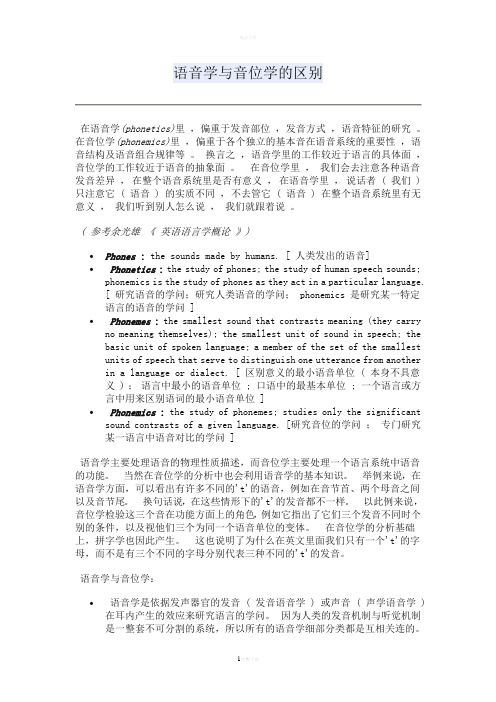
语音学与音位学的区别在语音学(phonetics)里,偏重于发音部位,发音方式,语音特征的研究。
在音位学(phonemics)里,偏重于各个独立的基本音在语音系统的重要性,语音结构及语音组合规律等。
换言之,语音学里的工作较近于语言的具体面,音位学的工作较近于语音的抽象面。
在音位学里,我们会去注意各种语音发音差异,在整个语音系统里是否有意义,在语音学里,说话者 ( 我们 ) 只注意它 ( 语音 ) 的实质不同,不去管它 ( 语音 ) 在整个语音系统里有无意义,我们听到别人怎么说,我们就跟着说。
( 参考余光雄《英语语言学概论》)•Phones : the sounds made by humans. [ 人类发出的语音]•Phonetics:the study of phones; the study of human speech sounds;phonemics is the study of phones as they act in a particular language.[ 研究语音的学问;研究人类语音的学问; phonemics 是研究某一特定语言的语音的学问 ]•Phonemes : the smallest sound that contrasts meaning (they carry no meaning themselves); the smallest unit of sound in speech; the basic unit of spoken language; a member of the set of the smallest units of speech that serve to distinguish one utterance from another in a language or dialect. [ 区别意义的最小语音单位 ( 本身不具意义 ) ;语言中最小的语音单位 ; 口语中的最基本单位 ; 一个语言或方言中用来区别语词的最小语音单位 ]•Phonemics : the study of phonemes; studies only the significant sound contrasts of a given language. [研究音位的学问;专门研究某一语言中语音对比的学问 ]语音学主要处理语音的物理性质描述,而音位学主要处理一个语言系统中语音的功能。
- 1、下载文档前请自行甄别文档内容的完整性,平台不提供额外的编辑、内容补充、找答案等附加服务。
- 2、"仅部分预览"的文档,不可在线预览部分如存在完整性等问题,可反馈申请退款(可完整预览的文档不适用该条件!)。
- 3、如文档侵犯您的权益,请联系客服反馈,我们会尽快为您处理(人工客服工作时间:9:00-18:30)。
语音学与音位学的区别
在语音学(phonetics)里,偏重于发音部位,发音方式,语音特征的研究。
在音位学(phonemics)里,偏重于各个独立的基本音在语音系统的重要性,语音结构及语音组合规律等。
换言之,语音学里的工作较近于语言的具体面,音位学的工作较近于语音的抽象面。
在音位学里,我们会去注意各种语音发音差异,在整个语音系统里是否有意义,在语音学里,说话者( 我们) 只注意它( 语音) 的实质不同,不去管它( 语音) 在整个语音系统里有无意义,我们听到别人怎么说,我们就跟着说。
( 参考余光雄《英语语言学概论》)
Phones :the sounds made by humans. [ 人类发出的语音]
Phonetics :the study of phones; the study of human speech sounds;
phonemics is the study of phones as they act in a particular language. [ 研究
语音的学问;研究人类语音的学问;phonemics 是研究某一特定语言的
语音的学问]
Phonemes :the smallest sound that contrasts meaning (they carry no
meaning themselves); the smallest unit of sound in speech; the basic unit of
spoken language; a member of the set of the smallest units of speech that
serve to distinguish one utterance from another in a language or dialect. [ 区
别意义的最小语音单位( 本身不具意义) ;语言中最小的语音单位;
口语中的最基本单位; 一个语言或方言中用来区别语词的最小语音单
位]
Phonemics :the study of phonemes; studies only the significant sound
contrasts of a given language. [研究音位的学问;专门研究某一语言中语音对比的学问]
语音学主要处理语音的物理性质描述,而音位学主要处理一个语言系统中语音的功能。
当然在音位学的分析中也会利用语音学的基本知识。
举例来说,在语音学方面,可以看出有许多不同的't'的语音,例如在音节首、两个母音之间以及音节尾。
换句话说,在这些情形下的't'的发音都不一样。
以此例来说,音位学检验这三个音在功能方面上的角色,例如它指出了它们三个发音不同时个别的条件,以及视他们三个为同一个语音单位的变体。
在音位学的分析基础上,拼字学也因此产生。
这也说明了为什么在英文里面我们只有一个't'的字母,而不是有三个不同的字母分别代表三种不同的't'的发音。
语音学与音位学:
语音学是依据发声器官的发音( 发音语音学) 或声音( 声学语音学) 在耳内产生的效应来研究语言的学问。
因为人类的发音机制与听觉机制是一整套不可分割的系统,所以所有的语音学细部分类都是互相关连的。
语音学的书写系统主要的重点在于能正确的纪录、转写所有由语音合成的音串,而其中最广为人知的书写系统就是International Phonetic
Alphabet。
每一个语言都使用人类所能发出的音中有限的音,这些音叫做
phonemes,而无论听者或是说话者,从小就被训练成可以将他们区分成
好几个音群、将无意义的语音排除。
因此说英语的人会忽略在其他语言中或许很重要的音,例如法文或西班牙文中的某些语音。
音位包含了所有关于语音特殊且有意义的差异,例如有声无声、发音部位、发音方式、重音、以及鼻化、声门式发音、双唇化发音等等。
研究音位的学问,就是一个语言的音位学。
